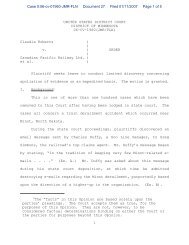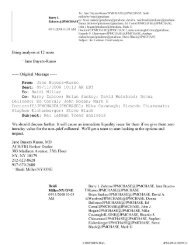Motorola, Inc. v. Lemko Corp
Motorola, Inc. v. Lemko Corp
Motorola, Inc. v. Lemko Corp
Create successful ePaper yourself
Turn your PDF publications into a flip-book with our unique Google optimized e-Paper software.
Case 1:08-cv-05427 Document 435 Filed 06/01/10 Page 1 of 11<br />
IN THE UNITED STATES DISTRICT COURT<br />
FOR THE NORTHERN DISTRICT OF ILLINOIS<br />
EASTERN DIVISION<br />
MOTOROLA, INC., )<br />
)<br />
Plaintiff, )<br />
)<br />
vs. ) Case No. 08 C 5427<br />
)<br />
LEMKO CORP., XIAOHONG SHENG, )<br />
SHAOWEI PAN, HANJUAN JIN, XIAOHUA )<br />
WU, XUEFENG BAI, NICHOLAS LABUN, )<br />
JINZHONG ZHANG, ANGEL FAVILA, )<br />
ANKUR SAXENA, RAYMOND HOWELL, )<br />
FAYE VORICK, and NICHOLAS DESAI, )<br />
)<br />
Defendants. )<br />
MATTHEW F. KENNELLY, District Judge:<br />
MEMORANDUM OPINION AND ORDER<br />
The defendants have moved under Federal Rule of Civil Procedure 26(b)(5)(B)<br />
for a determination that plaintiff <strong>Motorola</strong> <strong>Inc</strong>.’s claims of attorney-client and work<br />
product protection for certain documents requested in discovery are unfounded. Two of<br />
the defendants, <strong>Lemko</strong> <strong>Corp</strong>. and Shaowei Pan, have moved to retain the protective<br />
order designations of “attorneys’ eyes only” or “highly confidential” for certain<br />
documents. In this decision, the Court rules on both motions.<br />
1. <strong>Motorola</strong>’s privilege claims<br />
The first question on the privilege issue is what law applies. This case includes<br />
four federal or arguably federal claims and over a dozen state claims. <strong>Motorola</strong>’s<br />
federal claims are count one, a claim under the Computer Fraud and Abuse Act in<br />
which <strong>Motorola</strong> claims that certain defendants obtained proprietary information from
Case 1:08-cv-05427 Document 435 Filed 06/01/10 Page 2 of 11<br />
<strong>Motorola</strong> computers in excess of their authorization; count six, a claim in which<br />
<strong>Motorola</strong> seeks a declaratory judgment that certain patents held by and patent<br />
applications submitted by various defendants are <strong>Motorola</strong>’s property; and count<br />
seventeen, a claim in which <strong>Motorola</strong> alleges that <strong>Lemko</strong> has infringed <strong>Motorola</strong>’s<br />
copyright in certain source code. Defendant Sheng has asserted a counterclaim whose<br />
only remaining count is a federal discrimination claim; Pan has asserted a counterclaim<br />
that he is the rightful owner of certain inventions; and Wu and <strong>Lemko</strong> have asserted<br />
counterclaims that arise under state law.<br />
In federal court, matters of privilege are governed by federal common law,<br />
except “in civil actions and proceedings, with respect to an element of a claim or<br />
defense as to which State law supplies the rule of decision,” on which state law<br />
governs. Fed. R. Evid. 501. The rule, by its terms, is claim-specific; the governing law<br />
of privilege depends on what claim or defense is at issue.<br />
Defendants argue that Illinois privilege law governs; <strong>Motorola</strong> argues that the<br />
governing law is federal privilege law – specifically, federal privilege law as interpreted<br />
by the Federal Circuit, which hears appeals in patent cases. Given Rule 501’s claim-<br />
specific focus, the threshold question would appear to be what claim or claims the<br />
material on which privilege is asserted concerns. If the material pertains only to state<br />
claims, then Illinois law controls. If the material pertains only to federal claims, then<br />
federal law controls (which circuit’s law would depend on which federal claims the<br />
material concerns). If the material pertains to both state and federal claims, the issue is<br />
perhaps tougher. Though neither party has addressed the point, there are cases<br />
saying in that situation, federal privilege law governs. See, e.g., von Bulow by<br />
2
Auersperg v. von Bulow, 811 F.2d 136, 141 (2d Cir. 1987); Mem. Hosp. for McHenry<br />
County v. Shadur, 664 F.2d 1058, 1061 & n.3 (7th Cir. 1981). Both von Bulow and<br />
Memorial Hospital, however, were cases in which federal law applied narrower privilege<br />
protection than state law. The opposite is true in the present case. The scope of<br />
attorney-client privilege protection is arguably narrower under Illinois law than under<br />
federal law, based on Illinois’ adherence to the “control group” test in the corporate<br />
context.<br />
Case 1:08-cv-05427 Document 435 Filed 06/01/10 Page 3 of 11<br />
The Court has not located any decisions addressing what law applies when the<br />
evidence applies to both federal and state claims and state law applies narrower<br />
privilege protection. <strong>Motorola</strong> does not address this question; it essentially assumes<br />
that because there are patent issues in the case, Federal Circuit law applies.<br />
Defendants say that the material in question all concerns the state law claims, though<br />
they do not spill much ink trying to explain their contention.<br />
The material on which <strong>Motorola</strong> has claimed privilege appears to involve an<br />
“intellectual property review” in connection with a project that it was undertaking with<br />
another entity. As best as the Court can determine, the review concerned whether<br />
there was a potential for patent infringement. From this, <strong>Motorola</strong> leaps to the<br />
conclusion that Federal Circuit law controls. But given Rule 501’s claim-specific focus,<br />
the question is not the nature of the underlying work but rather the claim(s) being<br />
litigated on which the evidence is relevant. The primary case that <strong>Motorola</strong> cites, In re<br />
Spalding Sports Worldwide, <strong>Inc</strong>., 203 F.3d 800, 803 (Fed. Cir. 2000), says that Federal<br />
Circuit privilege law applies if the case is within the Federal Circuit’s exclusive appellate<br />
jurisdiction. It is conceivable that appellate jurisdiction in this case may lie with the<br />
3
Case 1:08-cv-05427 Document 435 Filed 06/01/10 Page 4 of 11<br />
Federal Circuit, due to the claim for declaratory judgment of ownership of patents and<br />
patent applications (though <strong>Motorola</strong> does not come right out and say that). But in<br />
Spalding Sports, the Federal Circuit was dealing with the question of what circuit’s<br />
privilege law applies, not with a federal-vs.-state-law question under Rule 501. There is<br />
no reason to believe that the Federal Circuit would disregard Rule 501 and apply its<br />
own privilege law with regard to a state-law claim.<br />
<strong>Motorola</strong> makes no showing – indeed, it does not attempt to do so – that any of<br />
the material on which it claims privilege concerns the patent-related claims asserted in<br />
the case. Nor does it argue that any of the evidence concerns its Computer Fraud and<br />
Abuse Act claim, its copyright infringement claim, or defendant Sheng’s discrimination<br />
counterclaim. Indeed, the issue regarding privilege first arose in connection with<br />
litigation over defendant Wu’s counterclaim under the Illinois Whistleblower Act, a state-<br />
law claim. There is no suggestion that the privilege issue relates to any claims other<br />
than that one. For these reasons, the Court concludes that defendants have the better<br />
of the argument and that Illinois privilege law governs.<br />
Illinois law confines attorney-client privilege protection in the corporate<br />
environment to communications involving the corporation’s “control group.” The control<br />
group includes top management as well as employees “whose advisory role to top<br />
management in a particular area is such that a decision would not normally be made<br />
without his advice or opinion, and whose opinion in fact forms the basis of any final<br />
decision by those with actual authority.” Consolidation Coal Co. v. Bucyrus-Erie Co., 89<br />
Ill. 2d 103, 120, 432 N.E.2d 250, 25 (1982); see also, e.g., Sterling Fin. Mgmt., L.P. v.<br />
UBS PaineWebber, <strong>Inc</strong>., 336 Ill. App. 3d 442, 448, 782 N.E.2d 895, 900 (2002).<br />
4
Case 1:08-cv-05427 Document 435 Filed 06/01/10 Page 5 of 11<br />
<strong>Motorola</strong>, which has the burden of showing the privilege applies on a document-<br />
by-document basis, has made no attempt to show that the communications in question<br />
involved members of its “control group” thus defined. As a result, it has failed to show<br />
the documents are protected by the attorney-client privilege under Illinois law.<br />
<strong>Motorola</strong> also argues that the documents are protected by the work product<br />
doctrine. The parties appear to agree that this question is governed by federal law.<br />
See Defs.’ Privilege Mot. at 14 & Reply at 9-12 (citing only federal cases); Pl.’s Privilege<br />
Resp. at 11-13. Under Federal Rule of Civil Procedure 26(b)(3), “a party may not<br />
discover documents . . . that are prepared in anticipation of litigation or for trial by or for<br />
another party or its representative (including the other party’s attorney, consultant,<br />
surety, indemnitor, insurer, or agent),” subject to certain exceptions that are not at<br />
issue. Fed. R. Civ. P. 26(b)(3)(A).<br />
<strong>Motorola</strong> has failed to provide evidence sufficient to carry its burden in this<br />
regard. The evidence tends to show that the materials in question concern a review<br />
routinely done by <strong>Motorola</strong> at the outset of new projects to determine the risk of patent<br />
infringement. The work product doctrine, however, applies to materials only if they “can<br />
fairly be said to have been prepared or obtained because of the prospect of litigation.”<br />
Logan v. Commercial Union Ins. Co., 96 F.3d 971, 976-77 (7th Cir. 1996) (emphasis<br />
added; internal quotation marks and citation omitted). In this regard, courts “distinguish<br />
between an investigative report developed in the ordinary course of business as a<br />
precaution for the remote prospect of litigation and materials prepared because some<br />
articulable claim, likely to lead to litigation . . . ha[s] arisen.” Id. at 977 (emphasis in<br />
original; internal citations and quotation marks omitted). <strong>Motorola</strong> has failed to show<br />
5
Case 1:08-cv-05427 Document 435 Filed 06/01/10 Page 6 of 11<br />
that the materials in question fall into the latter category. It has therefore not<br />
established a basis for work product protection.<br />
2. Attorneys’-eyes and highly-confidential designations<br />
The Court entered a protective order in April 2009 governing documents and<br />
other information produced in discovery. See Defs.’ Confid. Mot., Ex. B. The order<br />
provided for designation of certain types of documents and information as “confidential”<br />
and “highly confidential.” Under the April 2009 order, “highly confidential” information is<br />
available only to outside counsel of record, in-house counsel of corporate parties, one<br />
designated non-lawyer representative of each corporate party, and independent experts<br />
and consultants. Id. 7 & 9. This amounted to five persons for <strong>Motorola</strong>, not<br />
including experts and consultants.<br />
The Court amended the order in March 2010 to permit <strong>Motorola</strong> to show a small<br />
number of documents designated as highly confidential to one additional non-lawyer<br />
executive. See Order of Mar. 9, 2010 (dkt. no. 375). The Court will refer to this<br />
category of documents as protected under “highly confidential level two.”<br />
In May 2009, the Court ordered the electronic imaging of certain computers<br />
belonging to defendants Pan and Wu. The order provided that the images would be<br />
categorized as highly confidential information under the April 2009 protective order. In<br />
September 2009, the Court entered a supplemental protective order regarding the<br />
electronically stored information on the Pan / Wu computers. Id., Ex. A. The<br />
September 2009 order provided that the information was to be treated as “attorneys’<br />
eyes only” and would be accessible only to outside counsel of record who have filed an<br />
6
appearance in the case and to independent expert witnesses and consultants. Id. 1.<br />
In February 2010, <strong>Motorola</strong> asked <strong>Lemko</strong> and Pan to authorize disclosure of<br />
some 1,300 documents subject to the September 2009 order to nine <strong>Motorola</strong><br />
personnel, some of which are in-house attorneys and some of which are business or<br />
security personnel. <strong>Lemko</strong> and Pan object; they argue that many of the documents<br />
should remain in the attorneys’ eyes only category and that the others should be<br />
categorized as highly confidential level two. <strong>Motorola</strong> contends that this is insufficient to<br />
allow it to evaluate its claims and potential claims against the defendants and others.<br />
When a designation of materials as confidential under a protective order is<br />
challenged, the designating party bears the burden of justifying the need for<br />
enforcement of the order. See, e.g., Team Play, <strong>Inc</strong>. v. Boyer, No. 03 C 7240, 2005<br />
WL 256476, at *1 (N.D. Ill. Jan. 31, 2005); In re: Bank One Securities Litig., 222 F.R.D.<br />
1<br />
582, 586 (N.D. Ill. 2004). In this case, that means <strong>Lemko</strong> and Pan must show good<br />
cause for limiting disclosure of certain of the materials at issue to <strong>Motorola</strong>’s outside<br />
counsel and the rest to outside counsel, a few in-house lawyers, and one non-lawyer<br />
executive.<br />
Case 1:08-cv-05427 Document 435 Filed 06/01/10 Page 7 of 11<br />
In evaluating the present motion, the Court assumes that even if <strong>Motorola</strong> and<br />
1<br />
There is authority supporting an arguably different allocation of the burden of<br />
persuasion. In Andrew <strong>Corp</strong>. v. Rossi, 180 F.R.D. 338 (N.D. Ill. 1998), the court stated<br />
that the party seeking confidentiality must show the information is a trade secret or<br />
confidential business information and that there is good cause for a protective order,<br />
and that if this showing is made, the opposing party must demonstrate that the need for<br />
discovery outweighs the need for privacy. Id. at 340. Wherever the burden lies,<br />
however, the Court concludes that defendants have failed to show good cause for<br />
maintenance of the current classification of the materials in question or the revised<br />
classification they propose.<br />
7
Case 1:08-cv-05427 Document 435 Filed 06/01/10 Page 8 of 11<br />
<strong>Lemko</strong> do not now compete, there is the potential that they could. The Court also<br />
assumes the truth of defendants’ contention that the materials in question disclose the<br />
fact and information regarding relationships <strong>Lemko</strong> has with entities with which<br />
<strong>Motorola</strong> competes and/or has existing relationships.<br />
That, however, does not carry the day for defendants. They need to show that<br />
disclosure of these materials to a small number of <strong>Motorola</strong> business personnel, all of<br />
whom will be subject to non-disclosure / non-use restrictions under the Court’s<br />
protective order, presents a risk of disclosure (including inadvertently or accidentally) of<br />
sensitive competitive information. That is the test defendants themselves advocate.<br />
See Defs.’ Confid. Reply at 5. To support their contentions in this regard, defendants<br />
have submitted a number of the documents and the affidavit of defendant Bohdan<br />
Pyskir, <strong>Lemko</strong>’s president and chief operating officer. See id., Exs. E-H.<br />
Pyskir’s affidavit is largely conclusory. He says the materials at issue concern<br />
<strong>Lemko</strong>’s development, design, and implementation of cutting-edge communications<br />
technology and that disclosure “of any aspect” of this technology would put <strong>Lemko</strong> at<br />
risk that a competitor or potential competitor would learn of and use the technology. Id.,<br />
Ex. E 4-5. But he does not explain these statements – particularly the latter one –<br />
and support for them is not apparent from the documents themselves: the materials<br />
that defendants have chosen to provide to the Court all appear quite dated – they are<br />
2<br />
from 2004, 2005, and 2007. It is certainly not self-evident, and it is not apparent to the<br />
2<br />
Defendants state in one of their submissions that they can make other<br />
materials available to the Court if it wishes, but it is their burden to show need for<br />
limiting disclosure, not the Court’s burden to ferret it out.<br />
8
Court, that disclosure of the materials in question to a very small number of <strong>Motorola</strong><br />
personnel – the responsibilities of most of whom are legal and security-related – would<br />
pose the sorts of risks about which defendants are concerned. Pyskir’s conclusory<br />
statements are insufficient to show that the slight expansion of disclosure involved here<br />
to persons who will be subject to the Court’s protective order puts defendants at any<br />
appreciable risk. See Gulf Oil Co. v. Bernard, 452 U.S. 89, 102 n.16 (1981) (“To<br />
establish ‘good cause’ for a protective order under [Rule] 26(c), the courts have insisted<br />
on a particular and specific demonstration of fact, as distinguished from stereotyped<br />
and conclusory statements . . . .”) (quoting In re Halkin, 598 F.2d 176, 193 (D.C. Cir.<br />
1979) (internal quotation marks omitted)).<br />
Pyskir also says that <strong>Motorola</strong> competes with certain of <strong>Lemko</strong>’s suppliers and<br />
that it does business with one of them. Defs.’ Confid. Mot., Ex. E 7. He goes on to<br />
say that if <strong>Motorola</strong> used information from the materials in question to interfere with<br />
<strong>Lemko</strong>’s relationships, <strong>Lemko</strong> would be severely harmed. Id. That is, no doubt, true.<br />
But <strong>Lemko</strong> provides no basis for a determination that the limited expansion of the scope<br />
of disclosure sought by <strong>Motorola</strong> would lead to an appreciable risk of such harm. The<br />
handful of additional <strong>Motorola</strong> personnel that would have access to the information all<br />
would be required to execute a sworn undertaking not to disclose the information to<br />
others and to use it only in connection with assisting counsel. See Defs.’ Confid. Mot.,<br />
Ex. B at Ex. A.<br />
Case 1:08-cv-05427 Document 435 Filed 06/01/10 Page 9 of 11<br />
On the other side of the ledger (assuming the Court even needs to get there,<br />
given defendants’ failure to show a need for the extraordinarily restrictive limitations<br />
they seek to maintain), there is a legitimate need for <strong>Motorola</strong>’s outside counsel to be<br />
9
able to consult with client representatives other than lawyers. The Court cannot put it<br />
much better than the court in Arvco Container <strong>Corp</strong>. v. Weyerhaeuser Co., No. 1:08-cv-<br />
548, 2009 WL 311125 (W.D. Mich. Feb. 9, 2009):<br />
Discovery, trial preparation, and trial are made more difficult and<br />
expensive if an attorney cannot make complete disclosure of the facts to<br />
the litigant. Further, courts cannot ignore the fact that ninety-eight percent<br />
of cases are not tried, but are resolved in mediation and other settlement<br />
methods. It is difficult, and perhaps impossible, for an attorney to counsel<br />
a client to compromise or even abandon a case on the basis of<br />
information kept secret from the client. A litigant who is not in possession<br />
of all relevant facts, furthermore, is in a poor position to assess its<br />
obligation to evaluate its ongoing obligation to maintain only arguably<br />
meritorious actions at every stage of the case. Although the imposition of<br />
these and other handicaps upon a litigant is justifiable in some<br />
circumstances, such action by the court must be supported by a showing<br />
that disclosure will work a clearly defined and serious injury to the party<br />
seeking extraordinary confidential treatment.<br />
Id. at *6. As the Court has indicated, defendants have not made such a showing of risk<br />
of injury.<br />
Case 1:08-cv-05427 Document 435 Filed 06/01/10 Page 10 of 11<br />
Conclusion<br />
For the reasons stated above, the Court grants the motions of defendants for<br />
determination that plaintiff’‘s claims of privilege and protection are unfounded [# 377 &<br />
379] and denies the motion of certain defendants to retain attorneys’ eyes and highly<br />
confidential designations [# 412 & 414]. Plaintiff is directed to produce forthwith the<br />
documents that were the subject of the former motions, pursuant to whatever<br />
confidentiality designation is appropriate. Plaintiff may make available to the so-called<br />
“control group 9” the documents that were the subject of the latter motions. Defendant<br />
<strong>Lemko</strong>’s motion to stay interrogatory responses pending ruling on its motion to dismiss<br />
[# 381] is terminated because the Court denied the motion to dismiss on April 12, 2010,<br />
10
Case 1:08-cv-05427 Document 435 Filed 06/01/10 Page 11 of 11<br />
and <strong>Lemko</strong> and Pan’s motion to extend time [# 372] is terminated as moot.<br />
Date: June 1, 2010<br />
11<br />
_______________________________<br />
MATTHEW F. KENNELLY<br />
United States District Judge



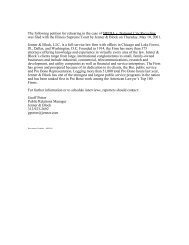

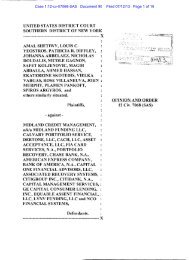
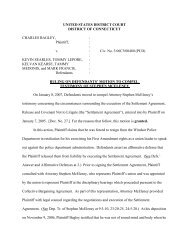

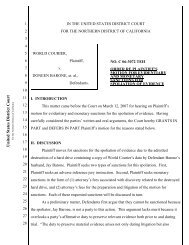
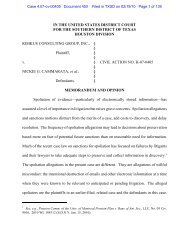
![Fontana, Thomas [CMB-RISK] [tf09146@imcnam.ssmb.com]](https://img.yumpu.com/14900567/1/190x245/fontana-thomas-cmb-risk-tf09146imcnamssmbcom.jpg?quality=85)
